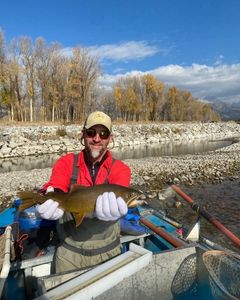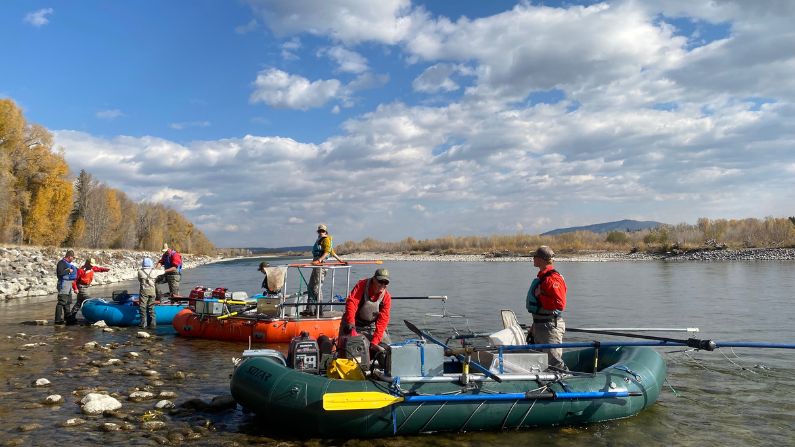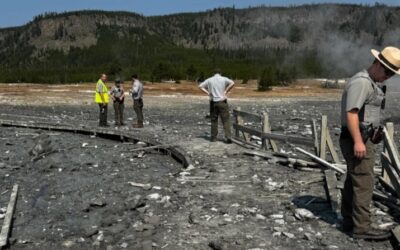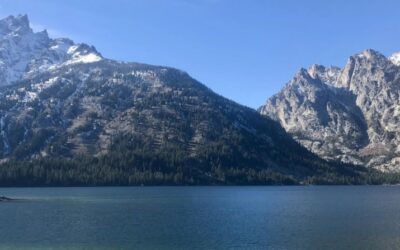Yellow aspens lined the banks of the Snake River between Moose and Wilson on Oct. 11, and three rafts drifted down the river.
The brisk fall day was one of three that Wyoming Game & Fish Department researchers spent on the water to check in on fish and conduct population estimates northwest of Jackson.
Instead of catching the fish individually, the crew was electrofishing. This allowed them to land a larger yield and get a more representative sample size of the population.
The researchers floated down the Snake on rafts with what look like metal antennas dangling off the front. Once in the water, the antennas released an electric field that temporarily stunned the fish.

The equipment on the raft releases an electric field, which temporarily stuns any fish within a 6- to 8-foot radius. (Hanna Merzbach/KHOL)
“They’re held in that field for just a few seconds, and the people in the front have to scoop them up really quick or else they’re off,” said Mark Smith, the department’s assistant fisheries management coordinator.
Smith explained that Game & Fish’s main focus that day was on Snake River cutthroat trout. Part of the species known as “cutties,” the trouts’ bodies are brownish-yellow and covered in small spots — except for their all-white belly.
Cutties are threatened throughout the Western United States, but this very stretch of water is a stronghold for the Snake River subspecies — and the department is making sure minor habitat changes don’t tip the scales.
Once the crews collected enough fish — sometimes over 100 in one swoop — they handed them over to a processing raft in a live cage for measuring.
First, the crew filled a cage with water on the processing raft. Then, they dumped the fish in.
“And at that point we’ll take those fish, and we’ll actually collect the biological data off of them, which is largely lengths and weights, which tell us a lot about the age and the conditions in the river,” Smith said.
The largest cuttie caught this day measured about 18 inches long. That’s not as big as what the staff found the week before on the National Elk Refuge’s Flat Creek, which is known for its trophy fish. Still, it’s significantly above average.

Darren Rhea, Game & Fish’s regional fisheries supervisor, holds up the 18-inch-long Snake River Cutthroat Trout. (Hanna Merzbach/KHOL)
The crew also made sure to make a small clip in one of each fish’s fins.
“We use that to determine when we come back in subsequent days whether we’ve encountered that particular fish in previous days,” Smith explained.
This year, the crew members ended up catching over 1,000 Snake River cutthroat trout over those three days. They’re now using this data to estimate the cutthroat population size in the stretch of river between Moose and Wilson.
The results aren’t out yet, but the department said all indications look good so far. The population likely won’t be as robust as in 2019, which saw the highest numbers ever recorded for this stretch. But they’ll probably fall within the long-term average of 600 to 800 trout per mile.
Fisheries biologist Clark Johnson said this shows that the Moose to Wilson stretch is still a stronghold for wild cutthroat trout.
“We, as an agency, in the area we don’t stock cutthroat trout very many places, so all the fish that folks are seeing or catching around the Jackson area are likely wild and the native fish that’s been here forever,” Johnson said.
Some of the fish had angling injuries, including some specimens that looked like they had been caught multiple times. The injury rate is low, but the crew said that over-angling may become the largest threat to the fish in years to come.
This is already a problem in places such as the North Platte River, which flows through Casper. There, an internal Game & Fish study showed that fish with more severe hooking injuries tended to be smaller than those without. Crew said that an injury like this can limit a fish’s ability to eat.
The cutthroat in the Moose-Wilson stretch are thriving in the face of other threats. They rely on cold, clean water, and Johnson said the cool climate in the Tetons has kept the Snake from warming like it has in other areas. These conditions have also kept non-native fish from gaining a foothold in the region.
“Luckily, in the greater Snake River area, those threats are pretty minimal, which is great, but the same can’t be said for some of the other subspecies in the state or in the region,” Johnson said.
Back on the raft, the crew took one more step before dumping the fish back in the water to safely swim away: they took clips of fin tissue from a selection of fish. They’re sending the samples to researchers at the University of Wyoming, who are trying to use genetics to see where exactly the fish originated from.
“We’re optimistic that genetics may be able to answer a really long-held question about where these fish all originate from in the system,” Smith said. “It might be that they come from many, many places. It also might be true that there’s certain streams or areas in the Snake River system that are critically important for the reproduction of cutthroat trout.”
For now, that research is a work in progress. Over those three days on the Snake, the crew caught fish of all sizes and ages. While the young trout might not have made any anglers jealous, they proved that the next generation of trophy fish is alive and well.





